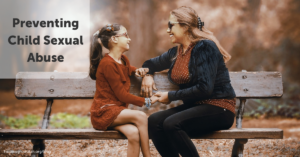 Child sexual abuse can be a scary topic. According to some studies, 1 in 5 children in the U.S. is sexually abused before reaching age 18. Often, the child knows the abuser. For any parent or future parent, the information and statistics about child sexual abuse are alarming. Becoming educated about preventing sexual abuse is a powerful tool for families, communities, and children. There are many practical and simple steps parents and caring adults can take to protect the children in their lives.
Child sexual abuse can be a scary topic. According to some studies, 1 in 5 children in the U.S. is sexually abused before reaching age 18. Often, the child knows the abuser. For any parent or future parent, the information and statistics about child sexual abuse are alarming. Becoming educated about preventing sexual abuse is a powerful tool for families, communities, and children. There are many practical and simple steps parents and caring adults can take to protect the children in their lives.
1) Teach children about boundaries- Teaching children about privacy and boundaries can help prevent sexual abuse. Requesting privacy for yourself (to change or use the restroom) is a good starting point for children to learn that certain activities should be done alone in private. Helping children understand the difference between a good secret (like what they get mom for Mother’s Day) versus a bad secret (anything they feel uncomfortable about) is another aspect of learning boundaries.
2) Speak openly to your child about healthy Sexual development- Talking to children about sex can be intimidating. If parents have an ongoing discussion about sex instead of just one hurried conversation, this can help children be more comfortable approaching their parents with questions. Saprea has a wonderful resource about different topics that can be discussed at different ages (starting as young as 2!) Dr. Julie Hanks did an interview where she talked about ways to answer questions children might have about sex. Something as simple as labeling body parts correctly helps children become more comfortable opening up about questions they might have. Children are naturally curious about this topic and getting information from parents will be the best.
3) Teach children about consent– Simply put, consent means giving permission. Parents can teach their children from birth that they have the right to choose what happens to their bodies. If someone is touching them in a way that makes them uncomfortable (even if that touch is innocent) it is okay for them to say no. Check out this book by Carrie Finison called Don’t Hug Doug about a little boy who would rather not be hugged. Teaching about consent is also a good time to let children know that they can always tell you if something or someone is making them feel uncomfortable.
4) Limit technology- Technology can be a positive learning tool for children, but there are certain dangers. A few ideas to make sure technology is safe for children include, limiting access, monitoring technology usage, and allowing children to help set up rules and boundaries. Many streaming services and phone plans allow parents to create child-safe filters that block harmful material.
There are many other ideas and resources available to help parents and other caring adults protect their children. Check out the links in this article for more information. Knowledge is power.





